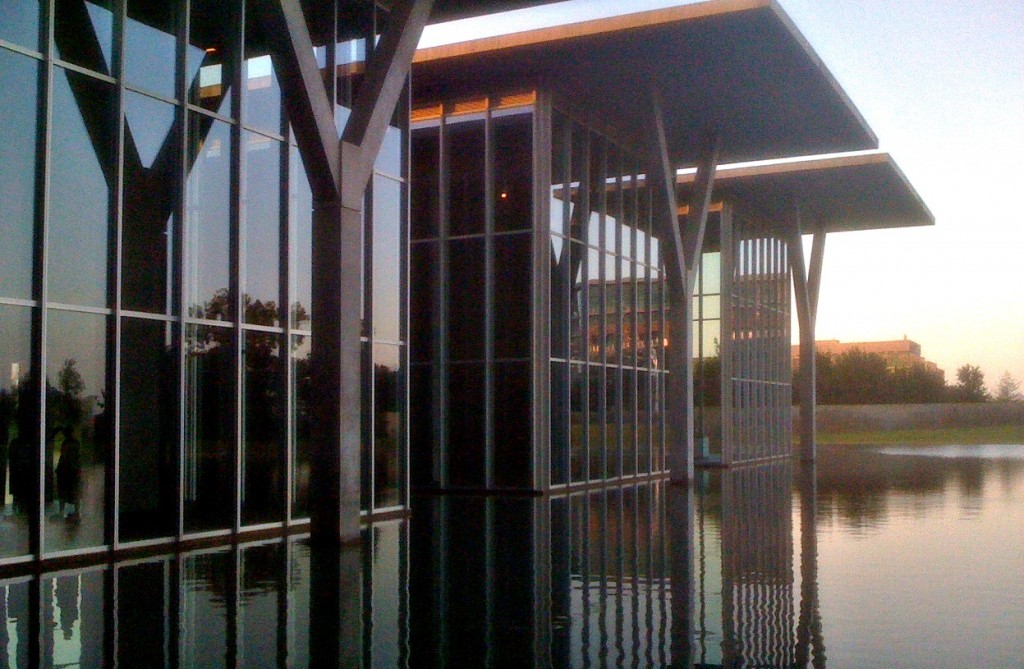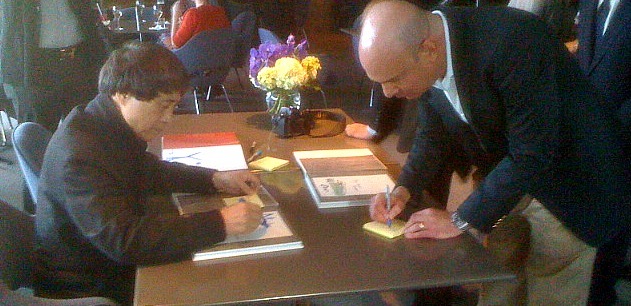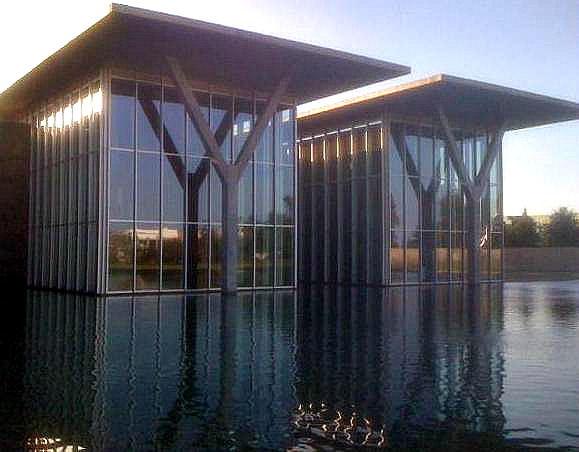Tadao Ando Modern Art Museum of Fort Worth Book
Information technology'southward been 10 years since the Japanese architect, Tadao Ando, visited his design, Modernistic Art Museum of Fort Worth. KERA's Jerome Weeks spoke with him.
KERA radio story:

The 71-year-old Tadao Ando landed viii hours agone from Osaka, Japan, and hasn't stopped since. There've been lectures and tours of other museums. Now he's autographing books in the Mod Art Museum café (beneath).
The Pritzker Prize-winner has reason to celebrate his creation. He'due south a prolific and prominent architect in Nihon. But the Modern was Ando's commencement major projection in the The states. The highly photogenic building has been his calling menu (almost literally: Light and H2o, Kenneth Frampton'south 2003 survey of Ando's work uses the Modern for its shimmering encompass shot). Ando says he at present regularly comes through DFW drome – on his way to new commissions in United mexican states and the US.
There'south another reason for Ando to value the Modern. It's next to the Kimbell Art Museum, designed by Louis Kahn.

Tadao Ando at book signing. Photo: Jerome Weeks
Ando says (through an interpreter), "For our generation of architects, Mr. Louis Kahn was similar a god. I think, in terms of peacefulness and the tranquility exuded past a building, probably nothing can compare to the Kimbell in the U.Due south."
UTD art professor Richard Brettell sees the influence as primal to the success of the Modern: "I recall the Mod pays homage to a building which he admires enormously and for that reason, information technology's a kind of leap for him."
Brettell reviewed the Modernistic in 2003 and expressed strong reservations about such things equally the edifice'due south noisy, oversized antechamber. But ultimately, even Brettell called the Modernistic the most important museum pattern since Frank Gehry's 1997 Guggenheim in Bilbao, Spain. Brettell says, "I do recall that the building has these moments of complete poesy."
Ando'due south renown as an builder derives from the Japanese traditions and the composure he brings to minimalist forms. These are by and large shaped out of silky-smooth physical, much similar the physical in the Kimbell, and a break with the beton brut (raw concrete, aka 'brutalism') of such before modernist masters equally Le Courbusier (meet, for instance, I.Thousand. Pei'southward Dallas City Hall vs. his afterward Meyerson). Many architects leave poured, pre-form concrete with the wooden grain and rough imprints left by the plywood and 2-by-fours that aid shape it (see the interior of the City Performance Hall). In contrast, Ando's pre-formed physical is extremely polished, virtually pristine. It'south a material he clearly loves, turning something humble and always-present into a precious stone-like shape.
Equally for the Japanese traditions he evokes and quotes, the Modern'due south main galleries are simply tall boxes. But their exteriors evoke formalism Japanese tea houses, tea houses sitting serenely past a swimming (below). Through Ando's use of sunlight and water, he's fabricated big blocks of reinforced concrete seem to float. As he says, "It was in my thinking to create really weightless space."
In particular, he borrowed the deep verandah and large overhang of the teahouse to shade the Modern's galleries, also equally the exterior walkway that often circles a tea house. In the Modern's case, the walkway is internal: Ando bundled the museum'due south galleries to be circled by the halls. That way, sunlight bounces through the halls and helps illuminate the galleries, but only indirectly.
Ando says, the water garden wasn't always in his plans. He did want the Modern's interior and exterior to interact, to intermingle, specially when it came to sunlight. Then he saw North Texas: "Information technology looked more than similar an arid desert. So the most important thing would be the water and copse."


The Mod's deep verandahs and its swimming site adapt traditions from the Japanese teahouse (right)
Many of Ando's well-nigh distinctive buildings seem to involve water in some course. Brettell believes that "water is something that he wants everything to be. Glass is water. The sheen of stone is water — you know, the sense of everything existence reflective."
The Modern is an oasis. Merely it'due south as well a building designed specifically for gimmicky fine art, with its layout and its high ceilings. The museum has showcased ix-foot-alpine cocky-portraits of Andy Warhol and Martin Puryear'southward sprawling, giant wooden sculptures.
Brettell says the museum has used the galleries well with its exhibitions. Ando agrees. He'southward pleased with how the Modern's turned out, how it's being run. "Construction is 1 thing," he says, "merely it'south the people that utilize the building who volition nurture and actually make the building work."
Nosotros're in the Modern's boardroom. Information technology's on the meridian floor and overlooks the water garden. An assistant pulls up the window shade to see the evening sun. Ando points to the pond and its reflections dancing on the Museum'southward glass walls.
"You see those very fine ripples of h2o, the low-cal reflected on the surface of the water?" he asks. "The water can't exist shallow. You need the right depths to take this effect.
"I actually honey it."
*********
Here's the release on the Modern's other 10th ceremony events, which include a number of new acquisitions and temporary loans existence put on display, get-go with KAWS' Companion (Passing Through) now outfront at the Modern (below).

The Modern Art Museum of Fort Worth Celebrates x Years in Tadao Ando-designed Edifice with New Acquisitions
Dec 2012 is the 10th anniversary of the Mod Art Museum of Fort Worth'south edifice designed by Tadao Ando. The Mod volition marking the anniversary with a series of new acquisitions on view this fall, culminating in a commemoration gala and dinner on Dec half-dozen, 2012.
Director Marla Cost comments, "These are exciting additions to the Modern's permanent collection. We are acquiring piece of work past important new artists in several cases and increasing our holdings of works by Vernon Fisher, Dan Flavin, Howard Hodgkin, Sol LeWitt, Bruce Nauman, and Nicholas Nixon."
Among the acquisitions is a rare early on wall drawing by Sol LeWitt (1928–2007), one of the pioneers of conceptual and minimal art. This is the third work by LeWitt to become part of the permanent collection. In the tardily 1960s and early 1970s, LeWitt began drawing lines directly on the walls of buildings, an activeness that radically transformed the office and definition of drawing in contemporary art. These drawings now be as a set up of signed instructions written by the artist, which are then executed past museum or gallery technicians. Wall Drawing #50A, 1970, consists of hundreds of hand-drawn lines in colored pencil (red, yellow, and bluish) stretching beyond a large wall, overlapping each other, and measuring approximately 11-by-16 feet. From a distance the aggregating of these lines creates a big, foggy plane of color, merely a closer look reveals a delicate spider web of intricately rendered lines.
Some other of import add-on to the Museum's significant holdings in minimal fine art is a Dan Flavin (1933–1996) low-cal sculpture, Untitled (for y'all Leo, in long respect and affection) 4, 1978, recently purchased at auction from the late Los Angeles collector Max Palevsky (1924–2010). Made of yellow and blueish fluorescent lite fixtures, the work is installed across the corner of a wall. This work was dedicated past Flavin to Leo Castelli, the famous contemporary fine art dealer from New York. The work is a archetype example of Flavin's talent for blending different colored lights to create a continually active and vibrant infinite. The blue and yellow tubes of light create various shades of green that emanate from the corner of the room. The Museum's permanent collection also includes Flavin's Diagonal of May 25, 1963, a white fluorescent light caused in 2002.
A monumental painting by creative person Mark Bradford (b. 1961), Los Angeles, volition also be unveiled as part of the commemoration, the start in the Modern's collection. Crafting semi-abstract paintings from fragments of the urban environment—billboard newspaper, posters, newsprint, and street debris—Bradford's works are layered with multiple materials and meanings. An African American who grew upward in south-central Los Angeles, the creative person's richly textured collages merge his fascination of the personal space of painting with the sprawling, continually changing street facades of the city and the detail political and racial tensions that nevertheless be there.
The Modern's newly acquired painting is titled Kingdom Day, 2010, and is i of Bradford'south virtually ambitious works to date, consisting of four 10-by-10-foot canvases. An homage to the Kingdom Twenty-four hours Parade in Los Angeles, which takes identify every January on Martin Luther Rex Jr. Day, the work specifically refers to the 1992 parade, the same year iv policemen were tried and acquitted for beating Rodney King, inciting riots throughout Los Angeles. The painting, which on first take appears about abstract, presents an cryptic and turbulent prototype. Various colored banners and words are obscured by a field of gestures that resemble sparks from an explosion. At the same time, the painting suggests a topographical read: a satellite view of the Southern California coast covered by violent atmospheric static.
Other new works to be debuted between September and December include a monumental charcoal drawing by creative person Robyn O'Neil (b. 1977), Los Angeles, entitled These Final Hours Comprehend At Terminal; This Is Our Ending, This Is Our By, 2007. This nearly 14-pes-wide cartoon depicts a vast ocean with a pocket-size figure that hangs over it by a thread. O'Neil's spacious drawing volition be contrasted with a small but potent recent painting entitled Ice, 2008–x, by Howard Hodgkin (b. 1932), which consists of an intensely blended bluish-white brushstroke advancing out of a reddish footing. O'Neil'south drawing is the starting time of her work to enter the permanent collection, and Hodgkin'south work is the third painting to be caused for the Modern.
A new video and sound installation past Bruce Nauman (b. 1941) volition also be unveiled during this anniversary celebration. The work, Studio Mix, 2010, is inspired past a set of finger exercises that the composer Béla Bartók wrote for children learning the piano. A video image of Nauman'due south hands enacting the possible combinations of the iv fingers and thumb is suspended in a dark gallery accompanied past three audio elements: Nauman's voice calling out the instructions for the different finger and thumb combinations; a pianoforte played by artist Terry Allen and recorded in response to Nauman's instructions; and Nauman intermittently speaking the words "for children, for children." The Museum's permanent collection also includes, Nauman's Setting a Skilful Corner (Allegory & Metaphor), 2000, caused in 2001.
In December, the xth anniversary month of the opening of the new building, the Museum volition present a pregnant, new installation by Jenny Holzer (b. 1950), her showtime to be caused by the Museum. This special commission (title to be announced, 2012) will exist unveiled at the gala on Dec 6. The creative person's signature, kinesthetic light-emitting diode (LED) signs, will deliver Holzer'southward controversial texts in "Ando blue," including many of her famous truisms: MONEY CREATES Sense of taste; YOUR OLDEST FEARS ARE YOUR WORST ONES; SLIPPING INTO MADNESS IS Expert FOR Comparing; MOTHERS SHOULDN'T Make TOO MANY SACRIFICES; LACK OF CHARISMA Tin can Be FATAL.
Holzer'due south glowing language volition travel downwards long channels that extend from 1 end of a central, large clerestory gallery to a glass wall at the edge of the pond, creating rivers of text that give the illusion of penetrating the h2o. This major work, among other surprises, will give the collection a new look for the next decade.
SCHEDULE
On view kickoff September nine:
KAWS, COMPANION (PASSING THROUGH), 2010
On loan to the Mod as office of the 10th anniversary celebration, this colossal piece of work—measuring sixteen feet in elevation—depicts one of KAWS's (b. 1974) iconic characters in three-dimensional grade and will be installed at the archway of the Museum. COMPANION (PASSING THROUGH) has traveled internationally over the by two years at such acclaimed venues as the High Museum of Art, Atlanta, Georgia; the Standard Hotel, New York, New York; the Aldrich Gimmicky Art Museum, Aldrich, Connecticut; and Harbour Metropolis, Hong Kong.
On view by October 21:
Sol LeWitt, Wall Drawing #50A, 1970
Dan Flavin, Untitled (for you lot Leo, in long respect and affection) 4, 1978
Nicholas Nixon(b. 1947), The Brown Sisters, Truro, Massachusetts, 2011 is the newest addition in Nixon'due south ongoing series of photographs, The Brown Sisters, initially caused past the Modern in 2005.
Mark Bradford, Kingdom Day, 2010
Robyn O'Neil, These Final Hours Embrace At Last; This Is Our Ending, This Is Our Past, 2007
Howard Hodgkin, Ice, 2008–10
On view past November 16:
Vernon Fisher (b. 1943), The Coriolis Result, 1987. A gift from the artist, this piece of work was previously on view in the special exhibition, Vernon Fisher: Thousand-Mart Conceptualism.
Bruce Nauman, Studio Mix, 2010
Unveiled during gala on December six. On view to the public December 7.
Jenny Holzer, title to be announced, 2012
EVENTS
10th Anniversary Gala and Dinner
Thursday, December half dozen
(ticket prices to exist announced)
Tuesday Evening Lecture Series
Tuesdays, 7 pm
September xi—David Dawson, artist and longtime assistant and friend of Lucian Freud
September 18—Nicholas Nixon, creative person
September 25—Rosson Crow, creative person
October ii—KAWS, artist
October 9—Martin Gayford, art critic, writer, and subject of the painting Man with a Blueish Scarf by Lucian Freud
Oct 16—Marlon Blackwell, FAIA, founder and principal of Marlon Blackwell Architect
October 23—Michael Auping, chief curator, Modern Fine art Museum of Fort Worth
October 30—Gary Simmons, artist
November 13—Bruce Nauman, creative person
Nov 27—Howard Rachofsky, art collector
December iv—Jenny Holzer, artist
Source: https://artandseek.org/2012/11/05/ten-years-on-architect-tadao-ando-returns-to-the-ftw-modern/
0 Response to "Tadao Ando Modern Art Museum of Fort Worth Book"
ارسال یک نظر